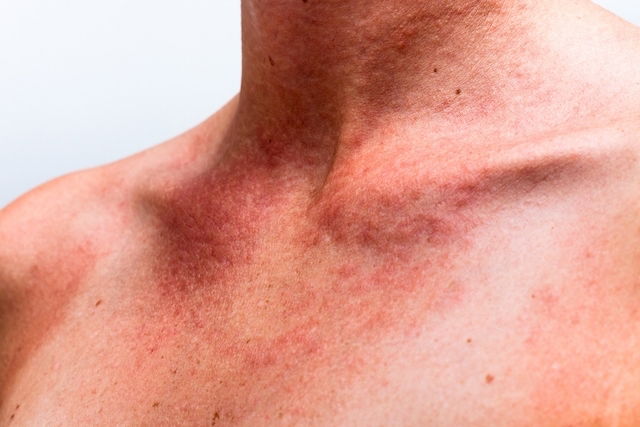A stress rash is an immune system response to emotions like stress and anxiety. It causes skin symptoms like itching and redness as well as systemic symptoms, like shortness of breath.
The causes behind stress rashes are not totally understood, however it seems to happen due to the production of catecholamines triggered by stress and anxiety. These substances increase the release of cortisol, causing an inflammatory reaction in the body.
Treatment for a stress rash is very similar to the treatment of other skin irritation or skin allergies. The doctor may prescribe antihistamines to relieve immediate symptoms, however psychological therapy may be advised for long-term management.

Main symptoms
The main symptoms of a stress rash include:
- Itchiness
- Skin redness
- Raised, red rashes or hives
- Skin swelling
- Shortness of breath
- Insomnia
Skin symptoms are most common, as the skin contains terminal nerve endings that are directly linked to feelings of stress and anxiety. People with other health conditions, like asthma, rhinitis, atopic dermatitis or psoriasis, may present with worsening of those related symptoms, and worse overall skin lesions when experiencing high-stress situations.
Also recommended: Psoriasis: Symptoms, 10 Types, Causes & Treatment Options tuasaude.com/en/psoriasisIt is important to remember that symptoms of a stress rash will range from person to person, depending on age, the intensity of emotions, coping mechanisms and genetics.
Possible causes
The causes of stress rashes are not fully understood, although it is known that feelings of stress and anxiety trigger several processes in the body. These emotions lead to the release of substances called catecholamines, which cause an inflammatory response in the skin.
Stress and anxiety can activate the defense cells of the body, leading to immune system hypersensitivity. This can present with skin-related symptoms and with worsening of other, pre-existing autoimmune diseases.
The release of cortisol and its inflammatory process during stressful situations can also affect the skin. Many patients have a genetic predisposition for these types of reactions.
Confirming a diagnosis
A stress rash diagnosis is confirmed by an allergist or dermatologist based on the assessment of the signs and symptoms presented by the patient. There is no test that confirms a stress allergy, however the doctor may order allergy tests to rule out other possible causes.
Treatment options
Treatment for a stress rash should be oriented by an allergy specialist or dermatologist. It often involves the use of antihistamines to relieve itching and redness. Stress rashes that last for over 2 weeks or present with very intense, sudden symptoms may require oral or topical corticosteroids.
Treatment outcomes can also be enhanced with medications that decrease stress and anxiety, as well as psychotherapy. Read more about anxiety medications that your doctor may consider prescribing.
